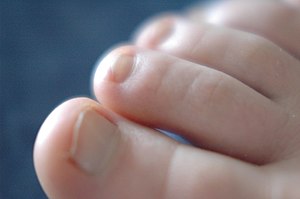| Rainbow striped toe socks worn with thong sandals (Photo credit: Wikipedia) |
Some traits a good sock may exhibit:
- Synthetic fibers or blends
- Correct construction and length
- Tactile stimulation
- Appearance
- Cushioning
- Temperature
- Longevity
- Smooth seams
A good pair of socks will help keep the feet warm in the winter and cool in the summer. This is due to fiber content and wicking capabilities. Some natural fibers such as Marino wool and silk have this ability, but once cotton gets damp, it stays damp and has a long drying time. Damp socks will bunch up and cause lumps. Look for synthetic or blends. Perhaps check out Aetrex socks that have copper ions embedded in the yarn.
Good socks perform a function. All things considered, they take care of your feet and form a barrier between your feet and shoes that provides healthy comfort. Keep your feet safer by changing socks to keep feet dry. Dark warm moist environments may allow fungus to gain a “foot hold,” and no one needs that.
If you think your socks may have let you down and you have corns from seams that have caused irritation, or the beginning of toenail fungus or any one of many other concerns, call Dr. Blaakman at (864) 487-3338. No need to get your socks in a bunch. Get an appointment and he can evaluate your concern and have you leave a happier and healthier person.
References:
http://www.askandyaboutclothes.com/forum/showthread.php?78201-More-Than-You-Ever-Wanted-To-Know-About-Top-Quality-Socks-2010-Update











